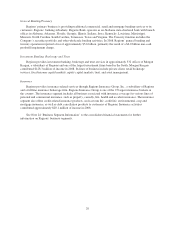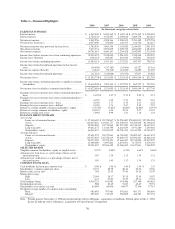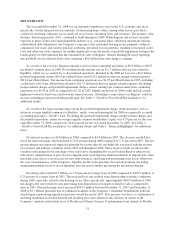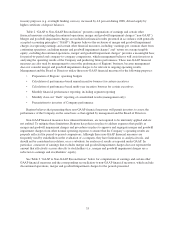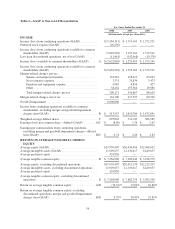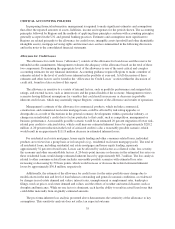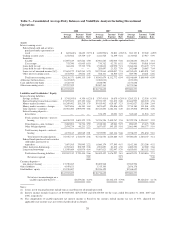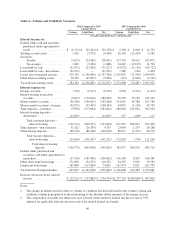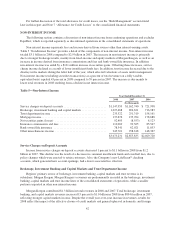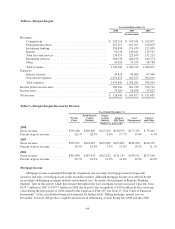Regions Bank 2008 Annual Report Download - page 46
Download and view the complete annual report
Please find page 46 of the 2008 Regions Bank annual report below. You can navigate through the pages in the report by either clicking on the pages listed below, or by using the keyword search tool below to find specific information within the annual report.Intangible Assets
Regions’ intangible assets consist primarily of the excess of cost over the fair value of net assets of acquired
businesses (goodwill) and other identifiable intangible assets (primarily core deposit intangibles). Regions’
goodwill is tested for impairment annually or more often if events or circumstances indicate impairment may
exist. Adverse changes in the economic environment, declining operations of the business unit, or other factors
could result in a decline in the estimated implied fair value of goodwill. If the estimated implied fair value is less
than the carrying amount, a loss would be recognized to reduce the carrying amount to the estimated implied fair
value.
For purposes of testing goodwill for impairment, Regions uses both the income and market approaches to
value its reporting units. The income approach consists of discounting long-term projected future cash flows,
which are derived from internal forecasts and economic expectations for the respective reporting units. The
projected future cash flows are discounted using cost of capital metrics for Regions’ peer group or a build-up
approach (such as the capital asset pricing model). The market approach applies a market multiple, based on
observed purchase transactions and/or price/earnings of Regions’ peer group for each reporting unit, to the last
twelve months of net income or earnings before income taxes, depreciation and amortization or price/tangible
book value. One of the critical assumptions in determining the estimated fair value of a reporting unit is the
discount rate, which can change based on changes in the business climate. A decrease in the discount rate by one
percentage point would result in an increase in fair value of approximately $1.0 billion for all reporting units and
an increase of approximately $600 million for the General Banking/Treasury reporting unit. An increase in the
discount rate by one percentage point would result in a decline in fair value of approximately $800 million for all
reporting units and a decline of approximately $500 million for the General Banking/Treasury reporting unit. A
variation in the discount rate may result in or from changes to other assumptions used in determining the
estimated fair value; these changes could materially affect the sensitivities described above.
If the estimated implied fair value of goodwill is less than the carrying amount, a loss would be recognized
to reduce the carrying amount to the estimated implied fair value. The changes or factors mentioned above, when
or if they occur, could be material to Regions’ operating results for any particular reporting period. As previously
discussed, Regions incurred a $6.0 billion impairment charge in 2008. See Note 1 “Summary of Significant
Accounting Policies” to the consolidated financial statements for additional information.
Other identifiable intangible assets, primarily core deposit intangibles, are reviewed at least annually for
events or circumstances which could impact the recoverability of the intangible asset, such as loss of core
deposits, increased competition or adverse changes in the economy. To the extent an other identifiable intangible
asset is deemed unrecoverable, an impairment loss would be recorded to reduce the carrying amount. These
events or circumstances, when they occur, could be material to Regions’ operating results for any particular
reporting period; the potential impact cannot be reasonably estimated.
Mortgage Servicing Rights
For purposes of evaluating mortgage servicing impairment, Regions must estimate the fair value of its
mortgage servicing rights (“MSRs”). MSRs do not trade in an active market with readily observable market
prices. Although sales of MSRs do occur, the exact terms and conditions of sales may not be readily available.
Specific characteristics of the underlying loans greatly impact the value of the related MSRs. As a result, Regions
stratifies its mortgage servicing portfolio on the basis of certain risk characteristics, including loan type and
contractual note rate, and values its MSRs using discounted cash flow modeling techniques. These techniques
require management to make estimates regarding future net servicing cash flows, taking into consideration
historical and forecasted mortgage loan prepayment rates and discount rates. Changes in interest rates,
prepayment speeds or other factors could result in impairment of the servicing asset and a charge against
earnings. Based on a hypothetical sensitivity analysis, Regions estimates that a reduction in primary mortgage
market rates of 25 basis points and 50 basis points would reduce the December 31, 2008 fair value of MSRs by
36





